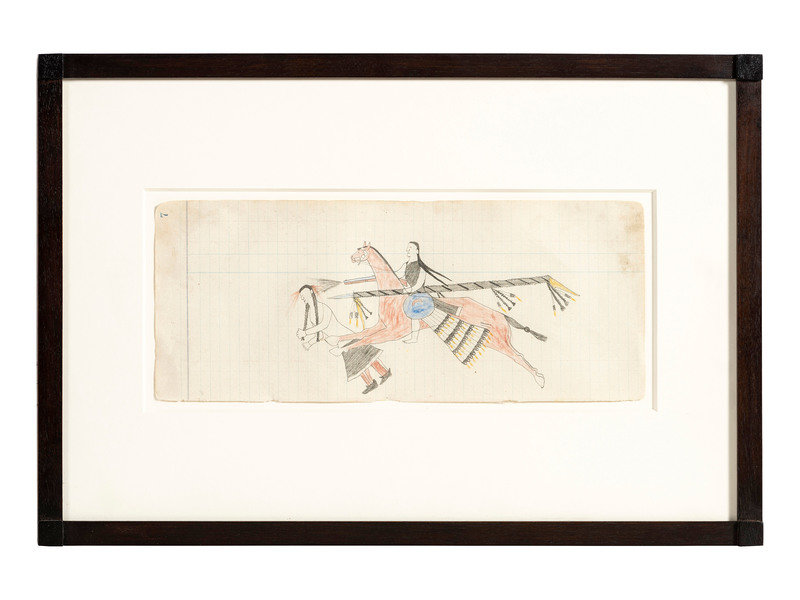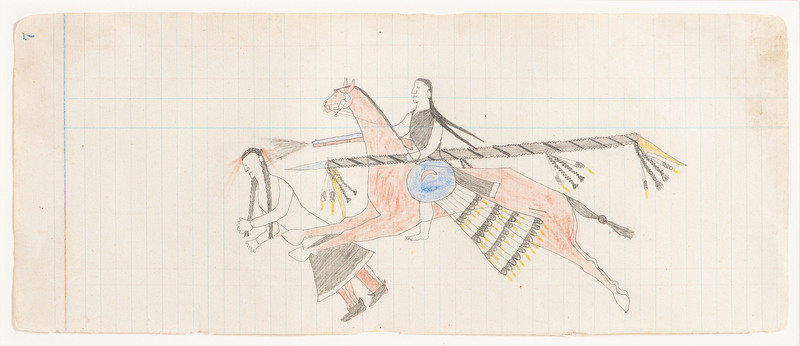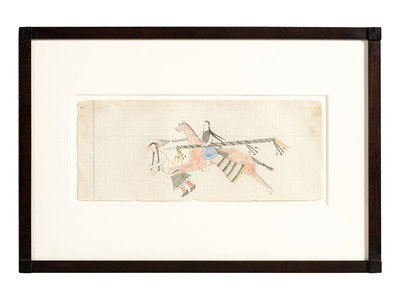plate #7, depicts a warrior astride a galloping pony; he wields a large straight lance, firing a rifle and killing a Pawnee warrior; the warrior also carries a distinct blue shield with a red moon design and a trailing drop of eagle feathers
(page size) 14-3/4 x 6-1/8 inches; (frame) 21-7/8 x 14-7/8 inches
Plate #7 of Arrow's Elks Society Ledger
by Ross Frank
(Frank, Ross. "plate #7 of Arrow's Elks Society Ledger." Plains Indian Ledger Art | https://plainsledgerart.org/plates/view/116#)
The very particular decoration of this Cheyenne's war lance identifies it as a weapon belonging to one of the officers of the Elk Society. Two such "straight lances" were carried by Elk officers, and two "crooked lances", which each had a curved end like a bishop's crozier opposite the point. In the south, the most common nickname for the Elk Society was Voxkaexomo, "Crooked Lances", after these distinctive weapons (Petter, 1915: 998; Petersen, 1964: 159).
Elk Society lances, whether of the straight or crooked variety, consisted of a wooden shaft eight or more feet long, with the steel blade of a knife, bayonet or sword set into one end. Originally, in the 18th century, elk tines or flaked-stone points had been used. The shaft was wrapped along its entire length with narrow strips of otter fur. The tag ends of this fur wrapping were allowed to hang down at the point and butt of the shaft, and were rubbed with yellow pigment on the flesh side of the otterskin.
At four points along the shaft were affixed as pendants a pair of golden eagle tail feathers, usually tipped with yellow-dyed horsehair; and a pair of narrow strips of otter fur, each tipped with a dewclaw that almost certainly was from the society's tutelary animal. Rattling together as the lance was handled in combat, these little "hooves' simulated and invoked the overwhelming charge of a bull elk.
Each of the narrow, otter fur pendants was further elaborated by being wetted, then twisted and allowed to dry. This imparted a permanent and stylish coil to each narrow strip. In Cheyenne drawings this feature is usually represented as it appeared in silhouette, as a dark zigzag. Undoubtedly these narrow strips, too, were painted yellow on the flesh side, connoting the power of lightning. Black and yellow colors, with ramifying zigzag images and symbols of lightning and thunder, are characteristic of Elk Society members, and their regalia.
Other than this lance, none of the Cheyenne's dress on this occasion identifies him certainly as the artist. Near-blood kin of the same sex and generation---brothers and cousins---often joined the same warrior society; and also purchased identical or similar shields, and other protective war talismans from respected visionaries (Marquis, 1931: 59; Moore, 1987: 267-73). The Cheyenne term for this relationship is "Nisson", and Moore calls it "perhaps the most important word in Cheyenne sociology" (1987: 267). It is possible, then, that this man could be a Nisson relative of the artist, and that both he and Arrow had earned the honor of bearing an Elk Society lance.
However, the otter-wrapped straight lance depicted here is identical to the others shown in Plates 27, & 163, where it is certain that Arrow is depicting himself; so it is likely that this, too, is a self-portrait. That being so, the shield shown here with a pendant trailer hung with four, overlapping tiers of golden eagle feathers may be the same shield depicted in Plate 27, where the same trailer is apparently in evidence. In this Plate Arrow has shown the simple, protective outer cover, while in Plate 27 he details the actual shield.
Such a cover was made of a circle of tanned leather, slightly larger than the thick, rawhide shield. The cover over-wrapped the shield, and was secured on the back by a drawstring run through slits along the circumference, rather like the drawstring on a laundry bag. The trailer with its tiers of feathers might be folded up, in sections, and secured under the cover; or it could be arranged to hang outside.
The crescent moon, here shown against the blue night sky, is one of the motifs most commonly found on Cheyenne shields. John H. Moore explains:
"The appearance of the night sky---pulsating, massive, blue-black and ominous...carries prominent overtones of death [and] the threat of death...The light of the moon repels the darkness of night, and keeps death more distant from living people. Therefore the moon, and moon-like objects on the earth, are seen to be protective, particularly from violent death" (Moore, 1974: 152-53).
This man is dressed rather carelessly, an unusual circumstance for any Cheyenne, who generally preferred to present as impressive an appearance as possible, in case they were killed and called to face their Creator (Marquis, 1931: 83). This evident haste suggests that the Cheyennes on this occasion came upon their foe unexpectedly. The man is shown bare-legged and barefoot, with the toes indicated; unlike Plates 1,2 & 5, for example, where undecorated moccasins are worn. He has a breechcloth of dark-blue wool (rendered as black). The black wool vest probably is worn over a long-sleeve, white cotton shirt; but it is possible that he is bare-armed as well. His hair flies loose, another indication of haste; and the long hair of the horse's tail has been quickly secured with an overhand knot, rather than being carefully wrapped and decorated.
Aside from the knotted tail and silver-mounted headstall, the only obvious concession toward preparing the horse for this encounter is the two, parallel lines painted on his left hip. These are seen again in use by Arrow in Plate 79; and by other Cheyennes in Plates 92 & 137. The same motif appears in other Cheyenne drawings, as well (Afton, et. al., 1997: Plate 91; Maurer, 1992: Cat. Nos. 190 & 259; Szabo, 1994b: Plate 31; Petersen, 1971: Figs. 52 & 53), used by women as well as men, so it may not be strictly in the nature of "war paint". In Szabo 1994b: Plate 20, this motif in sequence is used to indicate the tracks of a running buffalo. Probably in general it connotes speed, and a wish for the mount's sure-footedness.
The enemies whom the Cheyennes have rushed out to attack on this occasion are Pawnees, their most bitter foes. The tribal identity is indicated by black-painted moccasins with high ankle flaps; and in the case of Pawnee men, by a plucked scalp with a roach of short hair left along the crest, and one or two long scalplocks---see Plates 17, & 27. The victim here, however, is a woman. She is unarmed, and plainly being murdered. Her full skirt of dark-blue wool "saved list" cloth, with a long cotton over-blouse, and red wool trade cloth leggings, are characteristic of Pawnee women's clothing in this period. Compare the ca. 1870 photo of a Pawnee woman in Cowdrey, 1999: Fig. 6.
The Pawnees were among the oldest inhabitants of the Central Plains, maintaining earthlodge villages on the Loup Fork of the Platte River in northeastern Nebraska, where they farmed extensive crops of corn, beans, squash, sunflowers and melons during each spring and autumn. In summer and winter the villages were abandoned while the Pawnees switched to small tipis as they migrated west along the Platte or Republican rivers to hunt buffalo. They had followed this lifestyle for hundreds of years before the first, substantial group of Cheyennes moved into the Southern Plains about 1817 (James, 1823: 186-87).
The internecine hatred between the Pawnee and Cheyenne tribes seemingly existed from their earliest contacts, probably in the late-18th century. In that period the Pawnees far outnumbered the Cheyennes, and they were bold fighters. A bare three years after the first migration of Cheyennes to the South, when the Long expedition visited a Cheyenne camp on the Arkansas River in July 1820, this inter-tribal warfare was already well underway:
"The Shiennes...are habitually at war with all the nations of the Missouri: indeed, martial occurrences in which they are interested with those enemies formed the chief topic of their conversation with our interpreters. They were desirous to know of them the names of particular individuals whom they had met in battle, and whom they described; how many had been present at a particular engagement, and who were killed or wounded. [A] late battle...with the Loup Pawnees also occupied their inquiries; they...admitted their great numerical superiority [on that occasion], and the loss of many in killed and wounded.
"[A few days later, the expedition encountered] a Shienne war party on their return from the Pawnee Loups. They had killed one squaw, whose scalp was suspended to a spear of the partizan or leader of the party" (James, 1823, II: 186-87 & 197).
Doubtless the locks of the victim shown here, half a century later, suffered a similar fate.
Too much of the Cheyenne's rifle is obscured, for us to be sure of the intended make. The double ramrod pipes on the forestock, however, suggest that it could be a Lehman caplock trade musket, with the barrel cut down. It was common for the barrels of trade muskets to be shortened so they would be easier to handle on horseback (Marquis, 1931: 87).
ARROW, THE ELK SOCIETY ARTIST
by Mike Cowdry
(Cowdrey, Mike. “ARROW, THE ELK SOCIETY ARTIST.” Plains Indian Ledger Art | Arrow, https://plainsledgerart.org/essays/view/2.)
One record which has survived the flames of the 19th century is explored herein. Collected in 1882 at Darlington, Indian Territory, the Agency of the Cheyenne-Arapaho Reservation, it remained with the descendants of the collector Sallie C. Maffet, until sold at auction in 1997 (Sotheby's, 1997).
In five compositions (Plates 140, 144, 150, 154 & 160) the artist identifies himself by the name glyph of an arrow. This is undistinguished by color or shape, so the name seems to be intended generically as "Arrow". Cheyenne informants have indicated that such a name would be restricted to close family members of the Keeper of the Sacred Arrows, the tribal talisman. In the discussion accompanying Plate 27, Ledger Page 92, it will be developed that a close relationship existed between Arrow, and George Bent, the son of William, who founded Bent's Fort. George Bent was a grandson of the Arrow Keeper, so finding him associated with a man named "Arrow" is precisely what we should expect.
The 1880 census conducted at Cheyenne-Arapaho Agency (Oklahoma Historical Society, Microfilm CAA-4) is a wonderful source of information. Unfortunately, the sheets for many Cheyennes (particularly those of chiefly families) are missing, probably having been culled by historical researchers early in the 20th century. "Arrow" is among those names which are missing.
It is possible that he may have been in the north for a few years, although his name does not appear on the 1880 census of Northern Cheyennes either. After the Southern Cheyennes were defeated in 1875, some groups of Southerners fled north to join their Montana kinsmen, and participated in the great battles of 1876---the Rosebud fight, Battle of the Little Bighorn, and Battle to Save Morning Star's Village.
The "Last Bull" Ledger, a Northern Cheyenne Kit Fox Society record (American Museum of Natural History, Cat. No. 50.1/6618), page 55, depicts a man with the same "Arrow" name glyph standing alone against thirteen enemy marksmen, who have stolen a herd of the Cheyennes' horses (see Cowdrey, 1999: Introduction, Fig. a). This may represent the attack on Morning Star's village, Nov. 26, 1876. "When the soldiers charged, the Cheyennes at the lower end of the camp were nearly all on foot" (Grinnell, 1915: 375).
When the Cheyennes in the North surrendered in the spring of 1877, some individuals joined the free Miniconjou camp of Lame Deer, and others chose to remain in small hunting bands, unprotected but free (Marquis, 1931: 299, 316). Arrow may have been among these.
He had rejoined the Southern Cheyennes by 1884, for he is listed on the census made in July of that year, in "Band 57," where his name is glossed into English as "Flint". The Cheyenne word is Moxoz (Moh-ots), which can mean either the type of stone, or that which was most commonly made from it : a flint-tipped arrow (Petter, 1915: 60, 399). He was the "head of household" for seven unidentified others: his wife, another man, and five children. The other heads of household in the camp were Little Hand, Turtle, White Bear, Young Bull Bear, Bird in a Tree, One Eye and Red Lodge. All were likely relatives either of Arrow or his wife.
A year later (still called "Flint"), Arrow had moved to a different band. The 1884 group were probably Arrow's NISSON, his brothers and male cousins. By 1885 they had joined his wife's NISSON (sisters and female cousins), which was the more common Cheyenne residence pattern (Moore, 1987: 267-73). The household consisted of two men and their wives; the children were gone. It is unlikely that five children in one family died in a single year. More probably, the children had been young relatives from Arrow's NISSON, who had remained with their parents when Arrow joined his wife's family. The second man in the lodge was almost certainly a brother or cousin of Arrow, and the two had married sisters or cousins, a common Cheyenne practice.
The other men in Arrow's band of 1885 were Antelope, Red Bird, Flying Coyote, Morning Walker, Four Bulls, Apple, Lone Wolf, Short Teeth, Little Hand, and Young Bull Bear. It will be noted that the last two names had moved in company with Arrow. This most likely indicates that they were close relatives---brothers or cousins, all of whom had married sisters or cousins of the other band. It is likely that Little Hand and Young Bull Bear are two of the principals who appear in Arrow's drawings. Especially, Young Bull Bear may be the NISSON comrade who is shown in
Plates 90, 100, 112, 134, 136, 160 & 163. In the latter Plate, both men are shown as officers of the Crooked Lance, or Elk Warrior Society. A ceremonial shield of the Elk Society was collected from Young Bull Bear, ca. 1885 (National Museum of the American Indian, Wash., D.C., Cat. No. 23/2700).
After 1885, the name of Arrow, or "Flint" vanishes from the census records. He may have died then, or he may simply have changed names. At present, he cannot be tracked further. Since we do not know Arrow's whereabouts in 1882, we cannot be certain that it was he who sold his book of drawings. If he went to the North, the book could have been left with a relative or a friend, who might have sold it without Arrow's knowledge.
The evidence of the drawings, which is introduced in discussions of the Plates, is that they principally record events that occurred in 1874-75, during the Southern Cheyennes' last, desperate battles to save their homeland and their buffalo---their sustenance and the foundation of their religion. It is the story of a brave man who, in the crowded days of a beleaguered time, still found ways to joke with his friends, and to seek a little love in his life, while fulfilling his duties as a provider and protector.
It is also the record of an artist training himself, page by page, growing in skill and insight and technique, as he survives yet another day as one of those "chosen to be killed": Moxoz---Arrow, a Lance Bearer of the Elk Society.
Collected at Darlington, Indian Territory (Oklahoma) by Sallie C. Maffet (1882);
Sold through Sotheby's by Descendants of Maffet (1997); Morning Star Gallery, Santa Fe, NM; Private Collection, Chicago, IL



